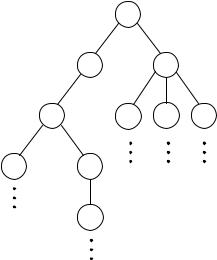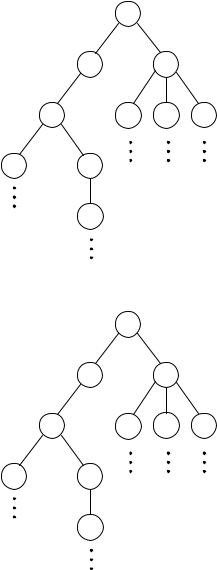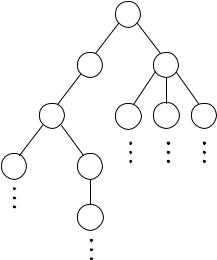
- •Contents
- •Foreword to the first edition
- •Preface to the second edition
- •Our motivation for (re)writing this book
- •What’s new and what’s gone
- •The interdependence of chapters and prerequisites
- •Acknowledgements
- •Added for second edition
- •1 Propositional logic
- •1.1 Declarative sentences
- •1.2 Natural deduction
- •1.2.1 Rules for natural deduction
- •1.2.2 Derived rules
- •1.2.3 Natural deduction in summary
- •1.2.4 Provable equivalence
- •1.2.5 An aside: proof by contradiction
- •1.3 Propositional logic as a formal language
- •1.4 Semantics of propositional logic
- •1.4.1 The meaning of logical connectives
- •1.4.2 Mathematical induction
- •1.4.3 Soundness of propositional logic
- •1.4.4 Completeness of propositional logic
- •1.5 Normal forms
- •1.5.1 Semantic equivalence, satisfiability and validity
- •1.5.2 Conjunctive normal forms and validity
- •1.5.3 Horn clauses and satisfiability
- •1.6 SAT solvers
- •1.6.1 A linear solver
- •1.6.2 A cubic solver
- •1.7 Exercises
- •1.8 Bibliographic notes
- •2 Predicate logic
- •2.1 The need for a richer language
- •2.2 Predicate logic as a formal language
- •2.2.1 Terms
- •2.2.2 Formulas
- •2.2.3 Free and bound variables
- •2.2.4 Substitution
- •2.3 Proof theory of predicate logic
- •2.3.1 Natural deduction rules
- •2.3.2 Quantifier equivalences
- •2.4 Semantics of predicate logic
- •2.4.1 Models
- •2.4.2 Semantic entailment
- •2.4.3 The semantics of equality
- •2.5 Undecidability of predicate logic
- •2.6 Expressiveness of predicate logic
- •2.6.1 Existential second-order logic
- •2.6.2 Universal second-order logic
- •2.7 Micromodels of software
- •2.7.1 State machines
- •2.7.2 Alma – re-visited
- •2.7.3 A software micromodel
- •2.8 Exercises
- •2.9 Bibliographic notes
- •3 Verification by model checking
- •3.1 Motivation for verification
- •3.2 Linear-time temporal logic
- •3.2.1 Syntax of LTL
- •3.2.2 Semantics of LTL
- •3.2.3 Practical patterns of specifications
- •3.2.4 Important equivalences between LTL formulas
- •3.2.5 Adequate sets of connectives for LTL
- •3.3 Model checking: systems, tools, properties
- •3.3.1 Example: mutual exclusion
- •3.3.2 The NuSMV model checker
- •3.3.3 Running NuSMV
- •3.3.4 Mutual exclusion revisited
- •3.3.5 The ferryman
- •3.3.6 The alternating bit protocol
- •3.4 Branching-time logic
- •3.4.1 Syntax of CTL
- •3.4.2 Semantics of computation tree logic
- •3.4.3 Practical patterns of specifications
- •3.4.4 Important equivalences between CTL formulas
- •3.4.5 Adequate sets of CTL connectives
- •3.5.1 Boolean combinations of temporal formulas in CTL
- •3.5.2 Past operators in LTL
- •3.6 Model-checking algorithms
- •3.6.1 The CTL model-checking algorithm
- •3.6.2 CTL model checking with fairness
- •3.6.3 The LTL model-checking algorithm
- •3.7 The fixed-point characterisation of CTL
- •3.7.1 Monotone functions
- •3.7.2 The correctness of SATEG
- •3.7.3 The correctness of SATEU
- •3.8 Exercises
- •3.9 Bibliographic notes
- •4 Program verification
- •4.1 Why should we specify and verify code?
- •4.2 A framework for software verification
- •4.2.1 A core programming language
- •4.2.2 Hoare triples
- •4.2.3 Partial and total correctness
- •4.2.4 Program variables and logical variables
- •4.3 Proof calculus for partial correctness
- •4.3.1 Proof rules
- •4.3.2 Proof tableaux
- •4.3.3 A case study: minimal-sum section
- •4.4 Proof calculus for total correctness
- •4.5 Programming by contract
- •4.6 Exercises
- •4.7 Bibliographic notes
- •5 Modal logics and agents
- •5.1 Modes of truth
- •5.2 Basic modal logic
- •5.2.1 Syntax
- •5.2.2 Semantics
- •Equivalences between modal formulas
- •Valid formulas
- •5.3 Logic engineering
- •5.3.1 The stock of valid formulas
- •5.3.2 Important properties of the accessibility relation
- •5.3.3 Correspondence theory
- •5.3.4 Some modal logics
- •5.4 Natural deduction
- •5.5 Reasoning about knowledge in a multi-agent system
- •5.5.1 Some examples
- •5.5.2 The modal logic KT45n
- •5.5.3 Natural deduction for KT45n
- •5.5.4 Formalising the examples
- •5.6 Exercises
- •5.7 Bibliographic notes
- •6 Binary decision diagrams
- •6.1 Representing boolean functions
- •6.1.1 Propositional formulas and truth tables
- •6.1.2 Binary decision diagrams
- •6.1.3 Ordered BDDs
- •6.2 Algorithms for reduced OBDDs
- •6.2.1 The algorithm reduce
- •6.2.2 The algorithm apply
- •6.2.3 The algorithm restrict
- •6.2.4 The algorithm exists
- •6.2.5 Assessment of OBDDs
- •6.3 Symbolic model checking
- •6.3.1 Representing subsets of the set of states
- •6.3.2 Representing the transition relation
- •6.3.4 Synthesising OBDDs
- •6.4 A relational mu-calculus
- •6.4.1 Syntax and semantics
- •6.5 Exercises
- •6.6 Bibliographic notes
- •Bibliography
- •Index
3.4 Branching-time logic |
211 |
3.4.2 Semantics of computation tree logic
CTL formulas are interpreted over transition systems (Definition 3.4). Let M = (S, →, L) be such a model, s S and φ a CTL formula. The definition of whether M, s φ holds is recursive on the structure of φ, and can be roughly understood as follows:
If φ is atomic, satisfaction is determined by L.
If the top-level connective of φ (i.e., the connective occurring top-most in the parse tree of φ) is a boolean connective ( , , ¬, etc.) then the satisfaction question is answered by the usual truth-table definition and further recursion down φ.
If the top level connective is an operator beginning A, then satisfaction holds if all paths from s satisfy the ‘LTL formula’ resulting from removing the A symbol.
Similarly, if the top level connective begins with E, then satisfaction holds if some path from s satisfy the ‘LTL formula’ resulting from removing the E.
In the last two cases, the result of removing A or E is not strictly an LTL formula, for it may contain further As or Es below. However, these will be dealt with by the recursion.
The formal definition of M, s φ is a bit more verbose:
Definition 3.15 Let M = (S, →, L) be a model for CTL, s in S, φ a CTL formula. The relation M, s φ is defined by structural induction on φ:
1.M, s and M, s
2.M, s p i p L(s)
3.M, s ¬φ i M, s φ
4.M, s φ1 φ2 i M, s φ1 and M, s φ2
5.M, s φ1 φ2 i M, s φ1 or M, s φ2
6.M, s φ1 → φ2 i M, s φ1 or M, s φ2.
7.M, s AX φ i for all s1 such that s → s1 we have M, s1 φ. Thus, AX says: ‘in every next state.’
8.M, s EX φ i for some s1 such that s → s1 we have M, s1 φ. Thus, EX says: ‘in some next state.’ E is dual to A – in exactly the same way that is dual to in predicate logic.
9.M, s AG φ holds i for all paths s1 → s2 → s3 → . . ., where s1 equals s, and all si along the path, we have M, si φ. Mnemonically: for All computation paths beginning in s the property φ holds Globally. Note that ‘along the path’ includes the path’s initial state s.
10.M, s EG φ holds i there is a path s1 → s2 → s3 → . . ., where s1 equals s, and for all si along the path, we have M, si φ. Mnemonically: there Exists a path beginning in s such that φ holds Globally along the path.

212 |
3 Verification by model checking |
φ
Figure 3.19. A system whose starting state satisfies EF φ.
11.M, s AF φ holds i for all paths s1 → s2 → . . ., where s1 equals s, there is some si such that M, si φ. Mnemonically: for All computation paths beginning in s there will be some Future state where φ holds.
12. M, s EF φ holds i there is a path s1 → s2 → s3 → . . ., where s1 equals s, and for some si along the path, we have M, si φ. Mnemonically: there Exists a computation path beginning in s such that φ holds in some Future state;
13.M, s A[φ1 U φ2] holds i for all paths s1 → s2 → s3 → . . ., where s1 equals
s, that path satisfies φ1 U φ2, i.e., there is some si along the path, such that M, si φ2, and, for each j < i, we have M, sj φ1. Mnemonically: All computation paths beginning in s satisfy that φ1 Until φ2 holds on it.
14.M, s E[φ1 U φ2] holds i there is a path s1 → s2 → s3 → . . ., where s1 equals s, and that path satisfies φ1 U φ2 as specified in 13. Mnemonically: there Exists a computation path beginning in s such that φ1 Until φ2 holds on it.
Clauses 9–14 above refer to computation paths in models. It is therefore useful to visualise all possible computation paths from a given state s by unwinding the transition system to obtain an infinite computation tree, whence ‘computation tree logic.’ The diagrams in Figures 3.19–3.22 show schematically systems whose starting states satisfy the formulas EF φ, EG φ, AG φ and AF φ, respectively. Of course, we could add more φ to any of these diagrams and still preserve the satisfaction – although there is nothing to add for AG . The diagrams illustrate a ‘least’ way of satisfying the formulas.

3.4 Branching-time logic |
213 |
φ
φ
φ
Figure 3.20. A system whose starting state satisfies EG φ.
φ
φ φ
φ φ φ φ
φ φ
φ
Figure 3.21. A system whose starting state satisfies AG φ.
Recall the transition system of Figure 3.3 for the designated starting state s0, and the infinite tree illustrated in Figure 3.5. Let us now look at some example checks for this system.
1.M, s0 p q holds since the atomic symbols p and q are contained in the node of s0.
2.M, s0 ¬r holds since the atomic symbol r is not contained in node s0.

214 |
3 Verification by model checking |
φ φ φ
φ
φ
Figure 3.22. A system whose starting state satisfies AF φ.
3.M, s0 holds by definition.
4.M, s0 EX (q r) holds since we have the leftmost computation path s0 → s1 → s0 → s1 → . . . in Figure 3.5, whose second node s1 contains q and r.
5.M, s0 ¬AX (q r) holds since we have the rightmost computation path s0 → s2 → s2 → s2 → . . . in Figure 3.5, whose second node s2 only contains r, but not q.
6.M, s0 ¬EF (p r) holds since there is no computation path beginning in s0 such that we could reach a state where p r would hold. This is so because there is simply no state whatsoever in this system where p and r hold at the same time.
7.M, s2 EG r holds since there is a computation path s2 → s2 → s2 → . . .
|
beginning in s2 such that r holds in all future states of that path; this is |
|
|
the only computation path beginning at s2 and so M, s2 AG r holds as well. |
|
8. |
M, s0 |
AF r holds since, for all computation paths beginning in s0, the system |
|
reaches a state (s1 or s2) such that r holds. |
|
9. |
M, s0 |
E[(p q) U r] holds since we have the rightmost computation path |
s0 → s2 → s2 → s2 → . . . in Figure 3.5, whose second node s2 (i = 1) satisfies r, but all previous nodes (only j = 0, i.e., node s0) satisfy p q.
10.M, s0 A[p U r] holds since p holds at s0 and r holds in any possible successor state of s0, so p U r is true for all computation paths beginning in s0 (so we may choose i = 1 independently of the path).
11.M, s0 AG (p q r → EF EG r) holds since in all states reachable from s0 and satisfying p q r (all states in this case) the system can reach a state satisfying EG r (in this case state s2).
